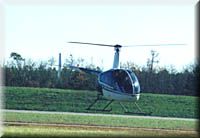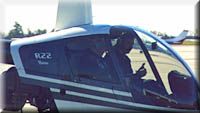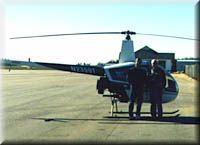 My Helicopter Lesson
My Helicopter Lesson
I Helicopters have always fascinated me at least as much as airplanes. I know they're outrageously expensive to fly but I'm still intrigued. . The more I've learned, the more interested I've become. I've been really confused and fascinated about how the controls worked so I figured the only way I'd ever really understand was to take a lesson! The first time I visited my son, Steve, in Raleigh, we'd stopped at Raleigh East airport and I noticed that the FBO was really a helicopter outfit, Raleigh Helicopter Service. Since we were visiting again this Thanksgiving (1998), I asked Steve to set up a lesson for me. The lesson was booked for 10:00 AM the day after Thanksgiving but it turned out Raleigh Helicopter has moved up to 2N9, Franklin County.
As with the night before my first fixed-wing lesson, I kept thinking about this one during the night. The day dawned crystal clear with just a bit of a wind but the briefing said winds at 3000' were 27 kts. Nonetheless, Steve and I set off for 2N9.
Having found Raleigh Helicopter, I found Glenn Brown, the guy who would be my instructor, out getting his race car ready for tomorrow's "legend car" race. Funny how each of us relaxes by doing something we don't get paid for. Sammy Snead used to say he played golf so he could afford to hunt and fish!
Franklin County airport was really nice. Hangers, etc. are in excellent condition and the strip is 5000' x 100'. Raleigh Helicopter Service is located in a brand new hanger at the north end of the airport. It has a fleet of 3 Robinson R22's which appeared to be in excellent condition. Unlike the fixed-winged aircraft, where I'd found them less expensive than expected, my expectations about the cost of these babies was accurate. New ones cost about $140K which isn't too bad but used ones go for about 120K! What's worse, the whole thing has a TBO of 2000 hours after which the entire aircraft needs to be re-built at a cost of about 70K! As a result, rentals are steep, too, with Dual time selling for $175/hr. Guess I'll stay in fixed-wing until I hit the lottery!
Glenn spent a fair about of time explaining how things worked before we got into the aircraft. The Robinson R22 is powered by a Lycoming O-320, just like my Cherokee but it's mounted "backwards" in the aircraft. In place of the prop is a large blower that's needed to cool the engine since it can't depend on forward movement to provide cooling air. The main and tail rotors are driven via two large belts and solid drive shafts. The rotors are disconnected from the engine during engine start and are only spun up after the engine is started.
Pitch of the tail rotor (and therefore aircraft yaw) is controlled by the foot pedals. As in a fixed wing machine, pressing the left pedal turns the nose to the left. Because of the rotation of the main rotor, the craft wants desperately to turn right so left pedal is needed, just opposite from fixed wing. Glenn said that left turns are much safer because, in some conditions, it's extremely difficult to stop a right turn once it's started.
The main rotor is controlled by two separate control devices, the collective and the cyclic. The collective, as the came implies, controls the pitch of both blades together. As a result, it essentially controls lift. Increased blade pitch takes a bigger bite of air and the aircraft goes up. The control itself is a lever operated by the left hand and resembles a hand brake in a car. (There are two of them, one to the left of each seat.) Lifting it, of course, is the way to make the aircraft climb. Mounted in the collective is a throttle operated in much the same way as that of a motorcycle. However, the R22 has a governor that can automatically take care of that detail.
The cyclic is the really tricky one. Through a complex mechanism, it individually controls the pitch of each blade so that the pitch changes as the blade rotates. As a result, the blades provide horizontal force to move the craft forward, back, or sideways. For example, to move forward, the blade traveling back towards the rear end of the craft has an increased pitch so it pushes the plane forward. The cyclic resembles the stick or yoke of a fixed wing plane but is infinitely more sensitive. I distinctively remember how sensitive I thought the yoke was during my first airplane lesson. By comparison, I didn't understand the concept of sensitivity! In the Robinson, there's a long lever extending vertically from the floor essentially in the center. At its top end is a horizontal bar, forming a "T". The joint between the vertical an horizontal bars is a pivot so the horizontal bar can stay horizontal as the vertical one moves through its arc. The ends of the horizontal bar are bent downward so there's a "handle" in front of each seat. It's this handle that the pilot uses as control input for the cyclic.
 Anyway, we finally boarded with me in the right seat. I'd heard that the right seat is the pilot's in helicopters but I learned that, while that's true in the Robinson, in some helicopters that's not the case. Instrumentation was familiar but sparser than in my plane. Remarkable by their absence were turn coordinator and attitude indicator but there were spaces on the panel for them and I later saw them in an R44. One goodie I thought was neat was a metal chip detector. There was one for each gearbox. The presence of chips would be indicated by a light on the panel. Now working from a checklist, Glenn fired up the engine and then flipped a switch that started to spool up the main rotor. That done, he engaged the governor and started lifting the collective. It was a bit windy so, as soon as the skid was off the ground, he was busy with cyclic and pedals holding the 'copter in position.
Anyway, we finally boarded with me in the right seat. I'd heard that the right seat is the pilot's in helicopters but I learned that, while that's true in the Robinson, in some helicopters that's not the case. Instrumentation was familiar but sparser than in my plane. Remarkable by their absence were turn coordinator and attitude indicator but there were spaces on the panel for them and I later saw them in an R44. One goodie I thought was neat was a metal chip detector. There was one for each gearbox. The presence of chips would be indicated by a light on the panel. Now working from a checklist, Glenn fired up the engine and then flipped a switch that started to spool up the main rotor. That done, he engaged the governor and started lifting the collective. It was a bit windy so, as soon as the skid was off the ground, he was busy with cyclic and pedals holding the 'copter in position.
Once up, Glenn flew us to a position over the grass and away from buildings, other craft, etc. so I could try my hand. First, of course, he demonstrated, then it was my turn. Our first operation was turning. That wasn't too bad but, when the wind caught the tail we turned pretty quickly. Next was the collective and that wasn't too bad, either; up and down is pretty simple. The cyclic, on the other hand, was another story! What an impossible thing to do! Glenn warned me what would happen and it did. Initially, all is well, then the plane will move in one direction, lets say forward. So, you pull back a tiny bit and it starts going backward. OK, forward on the cyclic and it goes forward again. Trouble is, each motion is bigger and faster than the last so in a few seconds, you're slamming all over the sky! Glenn would take control, stabilize it and turn it back to me. Then I'd have it out of control in well under a minute! This was outrageously frustrating. This condition is a result of helicopters being basically unstable while airplanes are basically stable. Fixed wing pilots know that, once a plane is trimmed, if you let go of the control, the plane will stay in control. Glenn emphasized that you can never release the cyclic. He said, if you do, the plane will quickly go out of control. When things get too far gone, the rotors then will swing around and strike the main mast, taking it off! Without a rotor, the day goes downhill pretty quickly!
After a while, Glenn said we'd go flying so up we went. He said you can go straight up but it's not very safe. By building some airspeed, you have some energy to trade for lift if the engine quits. Wind was coming from the southwest so airplanes were using runway 22. We took off in the same direction but over the parallel taxiway and flew a right pattern, climbing out at about 65 kts. Once we were moving, I found the helicopter a lot easier to control and eventually felt pretty comfortable. I flew to a lake, turned and flew to a field that was on fire and then to the airport. In flight, use of the foot pedals was not needed; it was just cyclic for direction and speed and collective for altitude. Controls felt really good and visibility was fantastic because, of course, we were sitting in a bubble. The experience was heightened by the near perfect air clarity; conditions were CAVU. Glenn said, even on cross country flights, they normally stay at about 1000 AGL. We were flying at about 700 AGL and it was neat looking around. As much as I love flying my airplane, I think I'd enjoy this even more! According to Glenn, the FAR's don't say a lot about helicopter flight and that squares with my recollection of what I'd read during my flight training. Minimum legal altitude is governed only by the need to avoid damage to persons or property on the ground on an engine out. To land, you only need permission of the landowner and to avoid violating local ordinances. For example, Glenn said you need a permit to land in Raleigh but he said he can get one readily if he needs it. If I had one of these machines, I could clear a few trees and park it in the back yard! What a way to get to work!
Back at the airport, we flew a tight right pattern back to the spot where we were hovering earlier and did it some more. What a frustrating experience! Reminded me of my emotions on trying to learn to land an airplane.
 I'd asked about engine outs so up we went again to demo the procedure. Glenn flew another right pattern, this time lining up on the runway itself. On ½ mile final, he pulled the power and down we went at about 1700 FPM! The trick was in working the collective to generate the right amount of lift. Just above the ground, he pulled up on the collective and back on the cyclic to flare and suddenly the descent stopped. Glenn added power just before we hit the ground and we went back to do more hovering practice. I started to get the hang of it a little but still, after a short time, I'd loose control. Soon the lesson was over and Glenn had me fly the helicopter to its parking place where he put it down with me following on the controls. Soon the engine was shut down and the experience was over. While we were gone, Steve had taken a lot of pictures. We posed for some final ones, took care of logbook and payment and we were off. I'd flown for 0.8 hours and spent $140. What a kick! As soon as I hit the lottery, I'm getting my rating!
I'd asked about engine outs so up we went again to demo the procedure. Glenn flew another right pattern, this time lining up on the runway itself. On ½ mile final, he pulled the power and down we went at about 1700 FPM! The trick was in working the collective to generate the right amount of lift. Just above the ground, he pulled up on the collective and back on the cyclic to flare and suddenly the descent stopped. Glenn added power just before we hit the ground and we went back to do more hovering practice. I started to get the hang of it a little but still, after a short time, I'd loose control. Soon the lesson was over and Glenn had me fly the helicopter to its parking place where he put it down with me following on the controls. Soon the engine was shut down and the experience was over. While we were gone, Steve had taken a lot of pictures. We posed for some final ones, took care of logbook and payment and we were off. I'd flown for 0.8 hours and spent $140. What a kick! As soon as I hit the lottery, I'm getting my rating!
